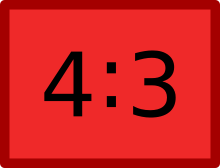
Back Verhouding Afrikaans ውድር Amharic نسبة (رياضيات) Arabic راصيو ARY অনুপাত Assamese Nisbət və tənasüb Azerbaijani Rasyo BCL Съотношение Bulgarian Ràtio Catalan ڕێژە CKB

In mathematics, a ratio (/ˈreɪʃ(i)oʊ/) shows how many times one number contains another. For example, if there are eight oranges and six lemons in a bowl of fruit, then the ratio of oranges to lemons is eight to six (that is, 8:6, which is equivalent to the ratio 4:3). Similarly, the ratio of lemons to oranges is 6:8 (or 3:4) and the ratio of oranges to the total amount of fruit is 8:14 (or 4:7).
The numbers in a ratio may be quantities of any kind, such as counts of people or objects, or such as measurements of lengths, weights, time, etc. In most contexts, both numbers are restricted to be positive.
A ratio may be specified either by giving both constituting numbers, written as "a to b" or "a:b", or by giving just the value of their quotient a/b.[1][2][3] Equal quotients correspond to equal ratios. A statement expressing the equality of two ratios is called a proportion.
Consequently, a ratio may be considered as an ordered pair of numbers, a fraction with the first number in the numerator and the second in the denominator, or as the value denoted by this fraction. Ratios of counts, given by (non-zero) natural numbers, are rational numbers, and may sometimes be natural numbers.
A more specific definition adopted in physical sciences (especially in metrology) for ratio is the dimensionless quotient between two physical quantities measured with the same unit.[4] A quotient of two quantities that are measured with different units may be called a rate.[5]
- ^ New International Encyclopedia
- ^ "Ratios". www.mathsisfun.com. Retrieved 2020-08-22.
- ^ Stapel, Elizabeth. "Ratios". Purplemath. Retrieved 2020-08-22.
- ^ "ISO 80000-1:2022(en) Quantities and units — Part 1: General". iso.org. Retrieved 2023-07-23.
- ^ "The quotient of two numbers (or quantities); the relative sizes of two numbers (or quantities)", "The Mathematics Dictionary" [1]
© MMXXIII Rich X Search. We shall prevail. All rights reserved. Rich X Search